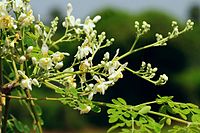
Quality retention and shelf life extension of fresh beef using Lepidium sativum seed mucilage-based edible coating containing Heracleum lasiopetalum essential oil: an experimental and modeling study
Sign Up to like & getrecommendations! Published in 2019 at "Food Science and Biotechnology"
DOI: 10.1007/s10068-019-00715-4
Abstract: The instability and strong flavor or odor of essential oils (EO) limit their direct incorporation into food products. In this study, the antioxidant and antimicrobial Heracleum lasiopetalum essential oil (HLEO) was added to Lepidium sativum… read more here.
Keywords: essential oil; beef; seed; heracleum lasiopetalum ... See more keywords

Microplastics accumulate on pores in seed capsule and delay germination and root growth of the terrestrial vascular plant Lepidium sativum.
Sign Up to like & getrecommendations! Published in 2019 at "Chemosphere"
DOI: 10.1016/j.chemosphere.2019.03.163
Abstract: The impacts of nano- and microplastics ( read more here.
Keywords: seed; plant; pores seed; germination ... See more keywords

Lepidium sativum seed oil 3D nano-oleogel for the management of diabetic wounds: GC/MS analysis, in-vitro and in-vivo studies
Sign Up to like & getrecommendations! Published in 2021 at "Journal of Drug Delivery Science and Technology"
DOI: 10.1016/j.jddst.2021.102504
Abstract: Abstract In this study, Lepidium sativum oil was used as the oily component of the prepared 3D nano-oleogels (NO) as well as the active ingredient. Different gelators were tested; all the formulae containing Labrafac™ Lipophile… read more here.
Keywords: nano; oil; lepidium sativum; seed ... See more keywords

Uptake and phytotoxic effect of benzalkonium chlorides in Lepidium sativum and Lactuca sativa.
Sign Up to like & getrecommendations! Published in 2018 at "Journal of environmental management"
DOI: 10.1016/j.jenvman.2017.10.077
Abstract: Cationic surfactants such as benzalkonium chlorides (BACs) are used extensively as biocides in hospitals, food processing industries, and personal care products. BACs have the potential to reach the rooting zone of crop plants and BACs… read more here.
Keywords: lepidium sativum; lactuca sativa; bacs; benzalkonium chlorides ... See more keywords

Development of Lepidium sativum Extracts/PVA Electrospun Nanofibers as Wound Healing Dressing
Sign Up to like & getrecommendations! Published in 2022 at "ACS Omega"
DOI: 10.1021/acsomega.2c00912
Abstract: Lepidium sativum L. (Garden cress/Hab El Rashad) (Ls), family Brassicaceae, has considerable importance in traditional medicine worldwide because of its antioxidant and anti-inflammatory activities. Ls fruits were used in Ayurvedic medicines as a useful drug… read more here.
Keywords: healing dressing; tee poly; lepidium sativum; wound healing ... See more keywords

Lepidium sativum natural seed plant extract in the structural and physical characteristics of polyvinyl alcohol
Sign Up to like & getrecommendations! Published in 2018 at "International Journal of Environmental Studies"
DOI: 10.1080/00207233.2018.1479564
Abstract: Abstract A virgin sample of pure polyvinyl alcohol (PVA) in combination with other polymeric samples containing pre-calculated amounts of lepidium sativum natural plant seed extract was successfully prepared. Structural modification was investigated through a combination… read more here.
Keywords: seed; sativum natural; plant; plant extract ... See more keywords

Protein changes in Lepidium sativum L. exposed to Hg during soil phytoremediation
Sign Up to like & getrecommendations! Published in 2017 at "International Journal of Phytoremediation"
DOI: 10.1080/15226514.2017.1284754
Abstract: ABSTRACT Some investigations have been carried out in this study to find the best technique of soil reclamation in mercurypolluted soil. In this study, we examined Lepidium sativum L. as a plant useful for Hg… read more here.
Keywords: protein; plant; protein changes; lepidium sativum ... See more keywords

The nutraceutical potential of Lepidium sativum L. seed flavonoid-rich extract in managing metabolic syndrome components.
Sign Up to like & getrecommendations! Published in 2019 at "Journal of food biochemistry"
DOI: 10.1111/jfbc.12725
Abstract: The present study aimed to investigate the phytochemical and pharmacological identities of a Lepidium sativum L. (LS) flavonoid-rich extract and its beneficial effects on metabolic, hormonal, and histological status. Chemical screening, as well as high-performance… read more here.
Keywords: rich extract; flavonoid rich; lepidium sativum; seed ... See more keywords

The Influence of pH of Extracting Water on the Composition of Seaweed Extracts and Their Beneficial Properties on Lepidium sativum
Sign Up to like & getrecommendations! Published in 2017 at "BioMed Research International"
DOI: 10.1155/2017/7248634
Abstract: Baltic seaweeds were used to obtain aqueous extracts (E) through changing initial pH of deionised water added to algal biomass (EpH3·H2O, EpH7·H2O, and EpH10·H2O) and through changing pH of the mixture of algae and deionised… read more here.
Keywords: water; h2o; lepidium sativum; algal extracts ... See more keywords

Nutraceutical Profiling, Bioactive Composition, and Biological Applications of Lepidium sativum L.
Sign Up to like & getrecommendations! Published in 2022 at "Oxidative Medicine and Cellular Longevity"
DOI: 10.1155/2022/2910411
Abstract: The roots, leaves, and seeds of Lepidium sativum L., popularly known as Garden cress in different regions, have high economic importance; although, the crop is particularly cultivated for the seeds. In traditional medicine, this plant… read more here.
Keywords: nutraceutical profiling; medicine; bioactive compounds; lepidium sativum ... See more keywords

Anti-inflammatory and Immunomodulatory Properties of Lepidium sativum
Sign Up to like & getrecommendations! Published in 2022 at "BioMed Research International"
DOI: 10.1155/2022/3645038
Abstract: Background Lepidium sativum (garden cress) is a member of the Brassicaceae family that has been utilized for medicinal and culinary purposes in centuries. Anti-inflammatory, antioxidant, immunomodulatory, hepatoprotective, antihypertensive, antiasthmatic, and hypoglycemic properties are found in… read more here.
Keywords: lepidium sativum; inflammatory antioxidant; antioxidant immunomodulatory; anti inflammatory ... See more keywords